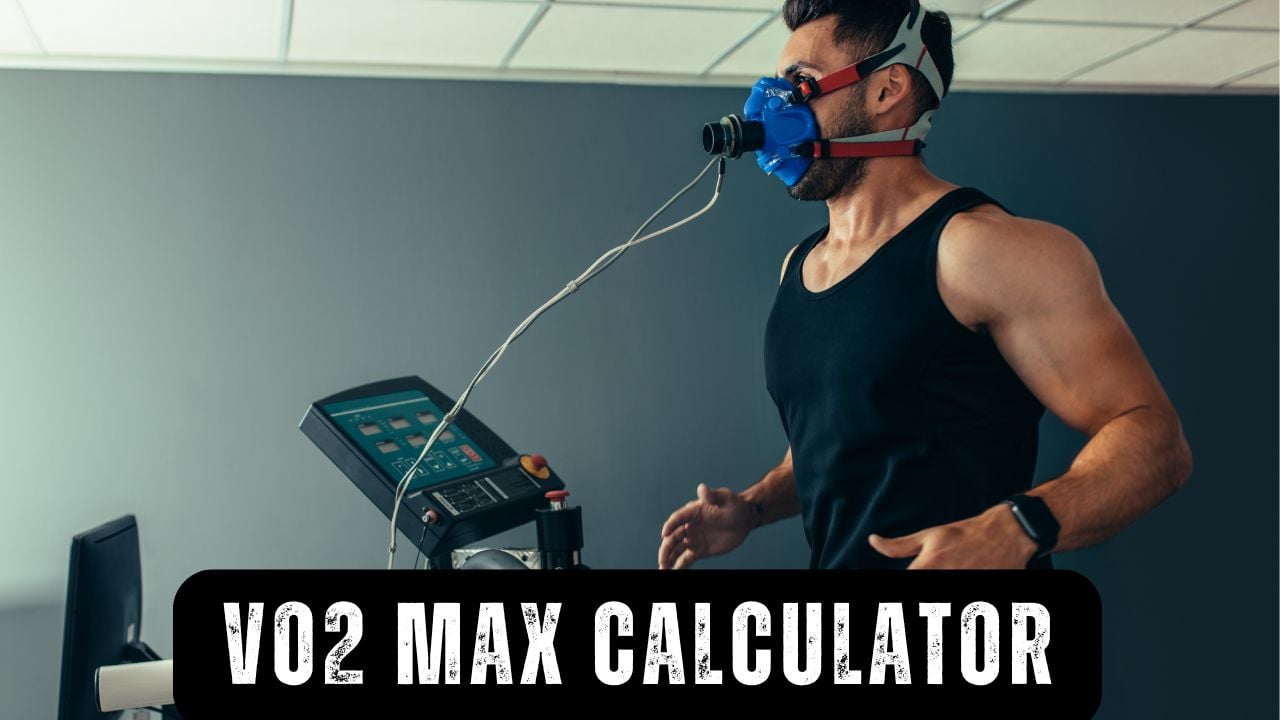VO2 Max Calculator – 5 Methods
Calculate your aerobic fitness using scientifically validated methods. Choose from 5 different testing protocols to assess your cardiovascular capacity.

VO2 Max Calculator
Calculate your VO2 max using 5 scientifically validated methods. Our comprehensive calculator employs research-backed formulas to assess your cardiovascular fitness and aerobic capacity accurately. Whether you’re a beginner looking to establish baseline fitness or an athlete optimizing performance, our multi-method approach provides reliable results for all fitness levels.
🎯 Accurate Assessment
Multiple validated formulas ensure reliable results across different fitness levels and testing preferences.
📊 Comprehensive Analysis
Detailed fitness level classification, METs calculation, and personalized training recommendations.
🔬 Scientific Backing
All formulas based on peer-reviewed research with high correlation to laboratory testing.
💡 Actionable Insights
Receive specific training protocols and improvement strategies based on your results.
5 Scientific Testing Methods
❤️ Resting Heart Rate Method
Best for: Beginners, quick assessment
Formula: VO2 max = 15.3 × MHR / (RHR × 3)
Accuracy: Moderate correlation with lab testing
🚶 One Mile Walk Test
Best for: Low-impact preference, older adults
Research: Validated by Kline et al.
Accuracy: High correlation (r=0.88) with VO2 max
🪜 Three Minute Step Test
Best for: Home testing, minimal equipment
Equipment: 12-inch step, stopwatch
Accuracy: Good reliability for population screening
🏃 1.5 Mile Run Test
Best for: Active individuals, military testing
Research: Widely used in fitness assessments
Accuracy: Strong correlation with laboratory values
🎯 Cooper 12-Minute Test
Best for: Athletes, competitive sports
Research: Established by Cooper (1968)
Accuracy: Gold standard for field testing
VO2 Max Fitness Standards
| Age Group | Gender | Poor | Fair | Average | Good | Excellent |
|---|---|---|---|---|---|---|
| 20-29 | Male | <25 | 25-33 | 34-42 | 43-52 | >52 |
| Female | <23 | 23-28 | 29-34 | 35-44 | >44 | |
| 30-39 | Male | <23 | 23-30 | 31-39 | 40-48 | >48 |
| Female | <20 | 20-25 | 26-31 | 32-40 | >40 | |
| 40-49 | Male | <20 | 20-27 | 28-35 | 36-44 | >44 |
| Female | <17 | 17-22 | 23-28 | 29-36 | >36 |
Understanding Your Results
🏆 Excellent (Top 20%)
Superior cardiovascular fitness. Typical of competitive athletes and highly trained individuals.
✅ Good (60-80%)
Above average fitness. Regular exercise routine with good cardiovascular health.
⚖️ Average (40-60%)
Typical fitness for age group. Meets basic health recommendations for physical activity.
⚠️ Fair/Poor (Bottom 40%)
Below average fitness. Significant room for improvement through structured exercise.
How to Improve Your VO2 Max
🏃♂️ High-Intensity Interval Training (HIIT)
Alternating periods of high-intensity exercise with recovery. Most effective method for VO2 max improvement with 15-20% gains possible.
Protocol: 4-6 intervals at 90-95% max heart rate for 3-5 minutes with equal rest periods.
🚴♀️ Aerobic Base Building
Long, steady-state cardio at moderate intensity. Builds aerobic capacity and endurance foundation.
Protocol: 45-90 minutes at 65-75% max heart rate, 3-5 times per week.
⛰️ Altitude Training
Training at elevation stimulates red blood cell production and improves oxygen delivery efficiency.
Benefits: 5-10% improvement in VO2 max, enhanced oxygen-carrying capacity.
💪 Strength Training
Resistance training improves muscle efficiency and supports cardiovascular adaptations.
Focus: Circuit training, compound movements, and functional strength exercises.
Scientific Formulas & Calculations
❤️ Resting Heart Rate Method
Formula: VO2 max = 15.3 × MHR ÷ (RHR × 3)
Where:
- MHR = Maximum Heart Rate (208 – 0.7 × age)
- RHR = Resting Heart Rate (bpm)
Accuracy: ±15% correlation with laboratory testing
Best for: Quick estimation, sedentary individuals
🚶 One Mile Walk Test (Kline Formula)
Formula: VO2 max = 132.853 – (0.0769 × W) – (0.3877 × A) + (6.315 × G) – (3.2649 × T) – (0.1565 × HR)
Where:
- W = Weight in pounds
- A = Age in years
- G = Gender (1 = male, 0 = female)
- T = Time in minutes
- HR = Heart rate after walk
Accuracy: r = 0.88 correlation with lab testing
Research: Validated by Kline et al. (1987)
🪜 Three Minute Step Test
Male Formula: VO2 max = 111.33 – (0.42 × HR)
Female Formula: VO2 max = 65.81 – (0.1847 × HR)
Where:
- HR = Heart rate 1 minute after test
- Step height = 12 inches (30.5 cm)
- Step rate = 24 steps/minute
Accuracy: Good reliability for population screening
Equipment: 12-inch step, metronome, stopwatch
🏃 1.5 Mile Run Test
Formula: VO2 max = (483 ÷ T) + 3.5
Where:
- T = Time in minutes to complete 1.5 miles
Accuracy: Strong correlation with laboratory values
Conditions: Flat course, consistent pace, maximal effort
Used by: Military, law enforcement fitness testing
🎯 Cooper 12-Minute Test
Kilometers: VO2 max = (22.351 × D) – 11.288
Miles: VO2 max = (35.97 × D) – 11.29
Where:
- D = Distance covered in 12 minutes
Accuracy: Gold standard for field testing (r = 0.90)
Research: Developed by Dr. Kenneth Cooper (1968)
Validation: Extensively validated across populations
🧮 METs Calculation
Formula: METs = VO2 max ÷ 3.5
Where:
- METs = Metabolic Equivalents
- 3.5 = Resting oxygen consumption (ml/kg/min)
Interpretation:
- <5 METs = Poor fitness
- 5-8 METs = Fair fitness
- 8-12 METs = Good fitness
- >12 METs = Excellent fitness
Frequently Asked Questions
❓ What is VO2 Max and why is it important?
VO2 max is the maximum amount of oxygen your body can utilize during intense exercise, measured in milliliters per kilogram of body weight per minute (ml/kg/min). It’s considered the gold standard for measuring cardiovascular fitness and aerobic endurance capacity.
Importance: Higher VO2 max indicates better cardiovascular health, improved athletic performance, and reduced risk of chronic diseases.
🎯 Which testing method is most accurate?
The Cooper 12-minute test and 1.5-mile run test are considered most accurate for field testing, with correlations of 0.90 and 0.85 respectively with laboratory VO2 max testing.
Laboratory testing using metabolic carts remains the gold standard, but these field tests provide excellent estimates for practical purposes.
📈 How quickly can I improve my VO2 Max?
Most people can see improvements in 6-12 weeks with consistent training:
- Beginners: 15-25% improvement in 8-12 weeks
- Intermediate: 10-15% improvement in 12-16 weeks
- Advanced: 5-10% improvement in 16-20 weeks
HIIT training typically produces the fastest improvements.
🏃♀️ What’s a good VO2 Max for my age?
VO2 max naturally declines with age, approximately 1% per year after age 30. Average values:
- 20-29 years: Men 44-51, Women 35-43
- 30-39 years: Men 40-47, Women 32-39
- 40-49 years: Men 36-43, Women 28-35
- 50-59 years: Men 32-39, Women 25-32
Elite endurance athletes often have values above 70 ml/kg/min.
⚖️ Does body weight affect VO2 Max?
Yes, VO2 max is expressed relative to body weight (ml/kg/min), so excess weight can negatively impact your score. However, absolute VO2 max (total oxygen consumption) may remain unchanged.
Weight loss benefits: Every pound lost can improve VO2 max by approximately 0.5-1.0 ml/kg/min.
🔄 How often should I test my VO2 Max?
Testing frequency depends on your goals:
- General fitness: Every 3-6 months
- Training programs: Every 6-8 weeks
- Athletes: Every 4-6 weeks during training cycles
Allow 48-72 hours rest before testing for accurate results.
🧬 Is VO2 Max genetic?
Genetics account for approximately 50% of VO2 max potential, but training can significantly improve your baseline:
- Genetic factors: Heart size, lung capacity, muscle fiber type
- Trainable factors: Cardiac output, oxygen extraction, mitochondrial density
Even with genetic limitations, proper training can achieve substantial improvements.
💊 Can supplements improve VO2 Max?
While no supplement can replace proper training, some may provide modest benefits:
- Beetroot juice: Nitrates may improve oxygen efficiency
- Iron: If deficient, supplementation can improve oxygen transport
- Creatine: May enhance high-intensity training capacity
Note: Focus on training consistency rather than supplements for best results.
Related
- Barbell Racking Calculator
- Push-Up Weight Calculator
- Wilks Calculator
- One-Rep (1RM) Max Calculator
- One-Rep Max (1RM) Bench Press Calculator
- Body Fat Calculator
References
- Tanaka, H., Monhan, K.D., Seals, D.G., Age-predicted maximal heart rate revisited. Am Coll Cardiol 2001; 37:153-156.
- Uth N, Sorensen H, Overgaard K, Pedersen PK. Estimation of VO2max from the ratio between HRmax and HRrest–the Heart Rate Ratio Method. Eur J Appl Physiol. 2004 Jan;91(1):111-5.
- Kieu NTV, Jung SJ, Shin SW, Jung HW, Jung ES, Won YH, Kim YG, Chae SW. The Validity of the YMCA 3-Minute Step Test for Estimating Maximal Oxygen Uptake in Healthy Korean and Vietnamese Adults. J Lifestyle Med. 2020 Jan 31;10(1):21-29. doi: 10.15280/jlm.2020.10.1.21. PMID: 32328445; PMCID: PMC7171059.
- Larsen, Gary & George, James & Alexander, Jeffrey & Fellingham, Gilbert & Aldana, Steve & Parcell, Allen. (2002). Prediction of Maximum Oxygen Consumption from Walking, Jogging, or Running. Research quarterly for exercise and sport. 73. 66-72. 10.1097/00005768-200205001-00022.
- Kilne G, et al. “Estimation of VO2 max from a one mile track walk, gender, age and body weight“. Med. Sci. Sports Exerc. 1987, 19: 253–259.
- Fahey, T., Insel, P., Roth, W., Fit & Well: Core Concepts and Labs in Physical Fitness and Wellness (Seventh Edition), McGraw-Hill, 2007.

Manish is a NASM-certified fitness and nutrition coach with over 10 years of experience in weight lifting and fat loss fitness coaching. He specializes in gym-based training and has a lot of knowledge about exercise, lifting technique, biomechanics, and more.
Through “Fit Life Regime,” he generously shares the insights he’s gained over a decade in the field. His goal is to equip others with the knowledge to start their own fitness journey.
